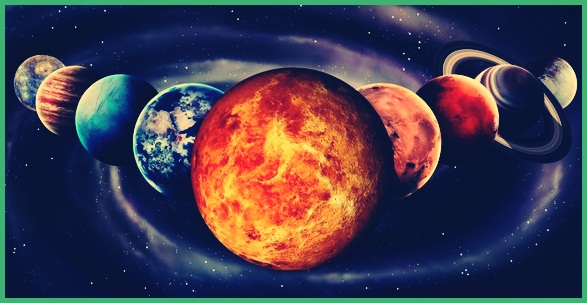Planet Venus
Planet Venus is a planet that is part of the solar system and the second closest planet to the sun after Mercury. For more details, see our discussion of the material for the planet Venus, including understanding, Features, Structure, and Geographic Info.
Table of Contents
Definition of Planet Venus

Venus is a planet that is part of the solar system and the second closest planet to the sun after Mercury.
This planet orbits or around the Sun takes as long as 224,7 earth day.
The color of the planet Venus is reddish-brown . Even scientists agree or agree that color should be the color used to describe Venus.
Different from Planet Mars, Venus has no natural satellites. The word or name “Venus” itself is taken from the name of the goddess of love or the goddess of beauty in Roman mythology.
Why is the name Venus taken from the name of the goddess of love?? Because Venus is the brightest celestial body in the night sky after Earth's satellite, the moon.
While in Arabic, this planet is known as Zuhara while from Sanskrit it is called Sita.
other than that, This planet is an inferior planet with an elongation angle that reaches 47.8o. It's called an inferior planet because this planet's orbit lies within the Earth's orbit around the sun
The maximum brightness of the planet can be seen before sunrise and after sunset, so this planet is called the morning star / twilight star.
Venus has the closest distance to Earth, the distance is approx. 42 million km, then this planet can be seen from Earth clearly with what looks like a small dot that is very bright sparkling like a star in the morning and evening..
Apart from the morning star, This planet is also called the star star when this planet is in the western angle position, as for the name of the evening star when the planet venus is in the east corner position.
In 225 Venus rotates around the sun in a nearly circular orbit in the solar system.
Based on the rotation, the planet also rotates on its axis during 243,1 day i.e. from east to west like most of the other celestial bodies.
Uniquely, This planet will rotate or rotate slightly tilted to the plane of its orbit.
other than that, Venus is always covered by thick clouds, if you look at the number of clouds, it is certain that Venus has a very thick atmosphere and contains a lot of water vapor, carbon dioxide, as well as oxygen.
The temperature on the surface of Venus is ± 480 °C , very hot to melt metals such as lead, seng, even aluminum.
Estimated 95% The atmosphere on Venus is made up of carbon dioxide, while nitrogen, neon, oxygen, hydrogen, and the amount of ammonia is not too much.
Likewise, water vapor only exists in very small quantities, ie is less than 1% of the total weight of air.
| Venus Geography Info |
| Venus is considered to be the greenhouse effect, This is because one of the hot temperatures is confined by CO2 in and under the sulfuric acid cloud layer.
other than that, the sun's rays reflect off the outer layers of clouds, which is then absorbed on the surface of Venus and then re-emitted as heat. Atmosfer CO2 absorb and hold this heat so that even at night the surface will remain warm. The rotation of this planet is very slow in its very thick and stormy cloud cover. So that the night on Venus lasts for 4 moon from earth. If in normal condition, the greenhouse effect is very much needed the difference in temperature between day and night on Earth is much different. The impacts or consequences of the greenhouse effect are as follows: : 1. Rising Earth's surface temperature |
Characteristics of the Planet Venus
Same thing with other planets, Venus has its own characteristics. The following are the characteristics possessed by Venus, when viewed based on the explanation above, the characteristics of Venus are as follows: :
| 1 | There is an atmosphere or a thick layer of gas because there are many dust clouds that surround it, making it difficult to investigate. |
| 2 | There is albedo(nature of white / light) the big one, due to many clouds. |
| 3 | In the atmosphere or gas layer found large amounts of carbon dioxide gas and water vapor has not been found. |
| 4 | Venus's diameter is as big as Earth's. |
| 5 | One year on Venus equals 225 day on Earth |
| 6 | The temperature during the day is 100 °C, cloud layer temperature at night -23 °C , Then there are no living things on venus. |
| 7 | The rotation is opposite of the other planets, and the rotation time is 244 day. |
| 8 | The old revolution is 224,7 day. |
Structure Planet Venus
The structure of Venus is covering the surface, layers, magnet, atmosphere and climate. The explanation will be as follows :
1. Surface of the Planet Venus
Most of the surface forms of Venus are volcanic areas, where the land was formed as a result of volcanic activity.
The volcanic land on Venus is only 80%, which one 70% it is a wrinkled rough land and the 10% smooth but wrinkled land.
While the volcanic highlands that exist on Venus are only 20%, i.e. is 2 highland continent, that is :
- Northern Continent (Ishtar Terra)
The northern continent is a slightly larger continent when compared to the Australian continent. The highest mountain located on the planet Venus is Mount Maxwell Montes which is located on Ishtar Terra ..
- Southern Continent (Aphrodite Terra)
The southern continent is a continent filled with fractures and faults on its surface which are most likely caused by active volcanic activity on the planet.
2. Inner Layers of the Planet Venus
Actually, there are not too many data that show the truth of the inner structure of this planet carefully.
In essence, Venus is similar to Earth, one could even say the two might have the same inner structure, which consists of the core, mantel & Need Bumi.
other than that, Venus and Earth cool at the same rate, the core of Venus will also be liquid.
3. Medan Magnet Planet Venus
The magnetic field that the planet Venus has is that it is on its surface and is very weak, but it does not have an internal magnet.
This statement makes it very surprising because the working system of Planet Venus and the earth is the same.
In addition, the internal magnet also comes from the dynamo in the core.
4. Atmosphere and Climate of Planet Venus
Atmosphere or layers of gas owned by the planet Venus are very numerous and dense, which the atmosphere consists of 96,5% carbon dioxide and 3,5% Nitrogen.
Massa atmosphere planet venus 93 times larger than the Earth's atmosphere, while the pressure 92 times greater than the pressure that occurs on the earth's surface.
1. There is an atmosphere or a thick layer of gas because there are many dust clouds that surround it, making it difficult to investigate.
2. There is albedo(nature of white / light) the big one, caused by a lot of clouds.
3. In the atmosphere found a large amount of carbon dioxide gas and water vapor has not been found.
(For more details, check the article)
The color of the planet Venus is reddish-brown. Even scientists agree or agree that color should be the color used to describe Venus.
Venus is a planet that is part of the solar system and the second closest planet to the sun after Mercury.
That's our explanation of the Complete Planet Venus Material. Don't forget to always visit our website so that you can get a lot of knowledge. Thank you.
Also read other articles :
- Southeast Asia Map
- Indonesian map
- World map
The post Planet Venus appeared first on YukSinau.co.id.
